Today's Progress 3. April. 2007
Generalization of &Sigma reconstruction/&Sigma N correlation analysis.
n&pi invariant mass spectra constructed from (n onNT, &pi onTC) and (n onTC, &pi onNT) events
For &Sigma particles, we have no way to improve invariant mass accuracy itself. We can generally activate....
1. Physical neutron condition, i.e. over 3MeVee light output .AND. 1/&beta within (1.6,9.0),
2. Elimination of &Lambda events from p&pi invariant mass if proton is additionaly detected somewhere.
The resulting n&pi invariant mass spectra are shown below. Due to the bad resolution and inaccuracy of the pion flight time, &Sigma peak is not seen on (n onNT, &pi on TC) events, while is clearly seen on (&pi onNT, n on TC) events.
n&pi invariant mass spectra constructed from (n onNT, &pi onTC) and (n onTC, &pi onNT) events.
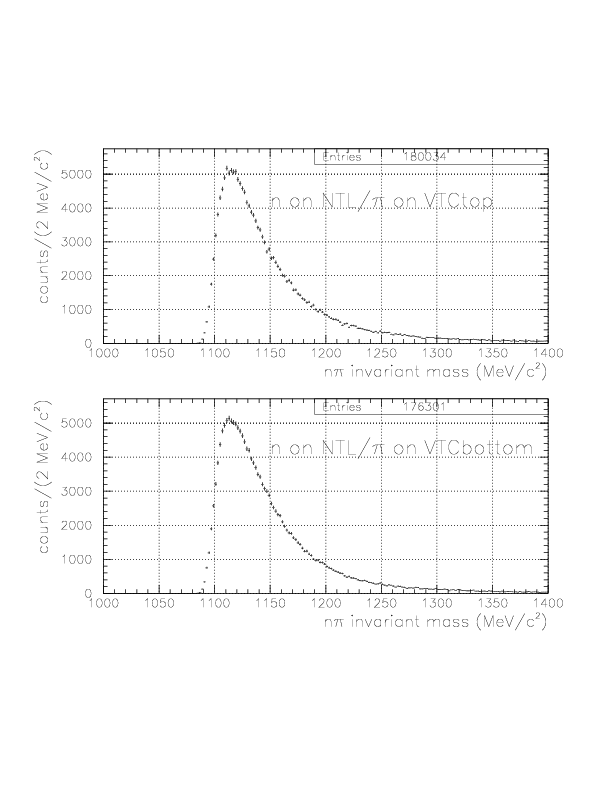
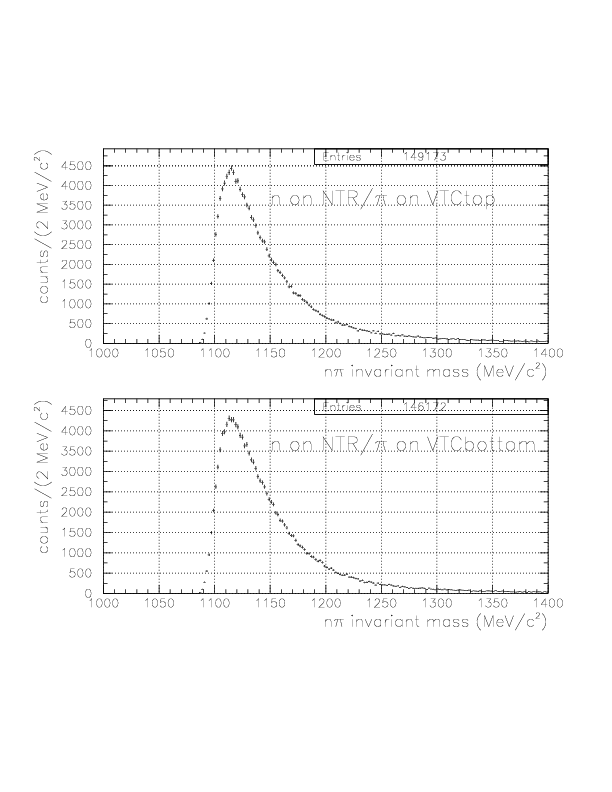
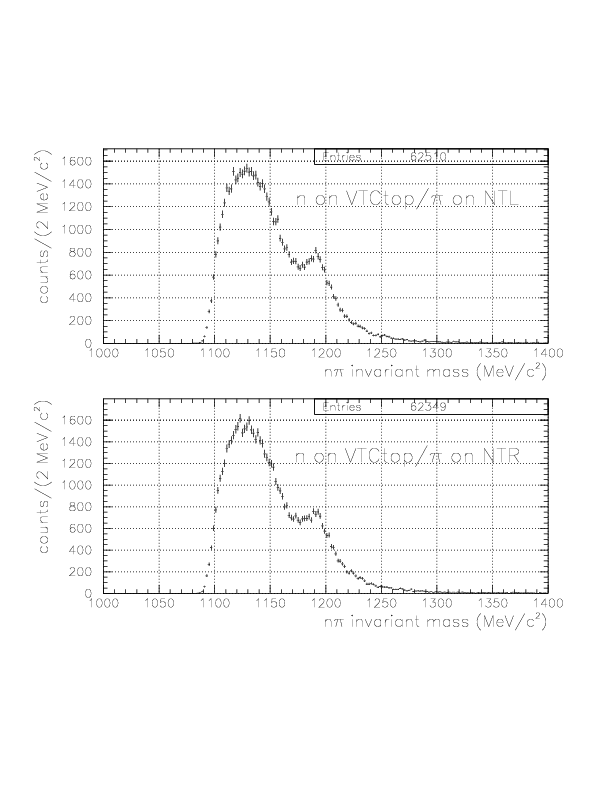
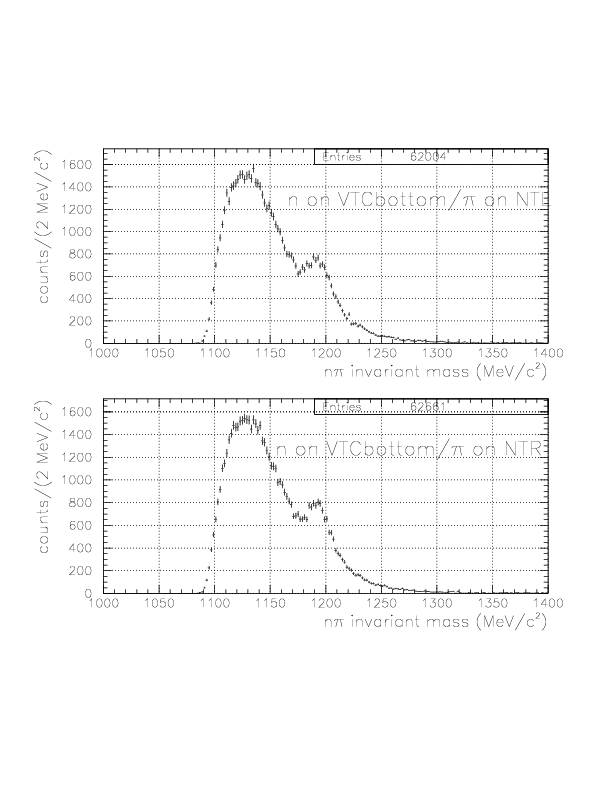
Suppression of combinatorial background by VcaVn
Additionally,
VcaVn positive selection,
fast &pi selection for &pi on VTC,
Neutron momentum selection,
will work according to the situation. It should be noted that the all three kill the real events to some extents, and the third one even bias the resulting spectra. Here, we just apply VcaVn, and other degree of freedom is kept for case-by-case study.
n&pi invariant mass spectra constructed from (n onNT, &pi onTC) and (n onTC, &pi onNT) events. The events with positive VcaVn are plotted by red, while green if not.
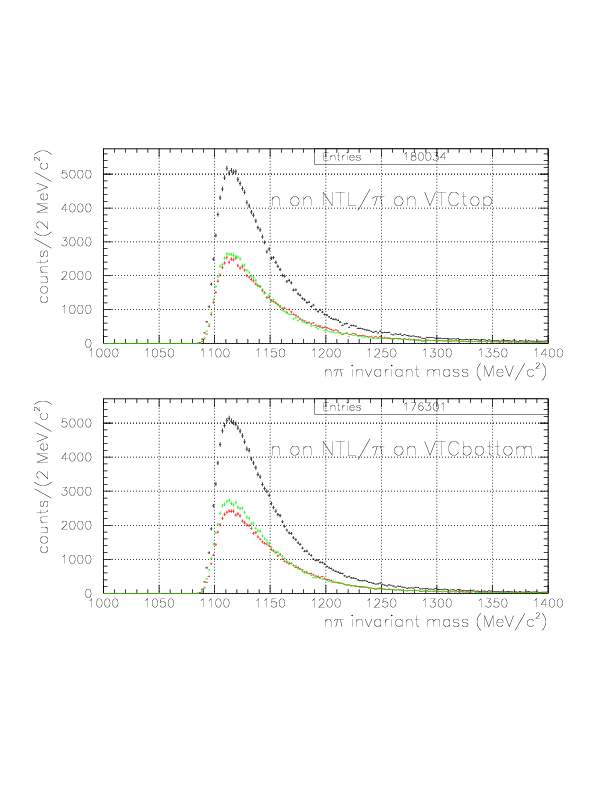


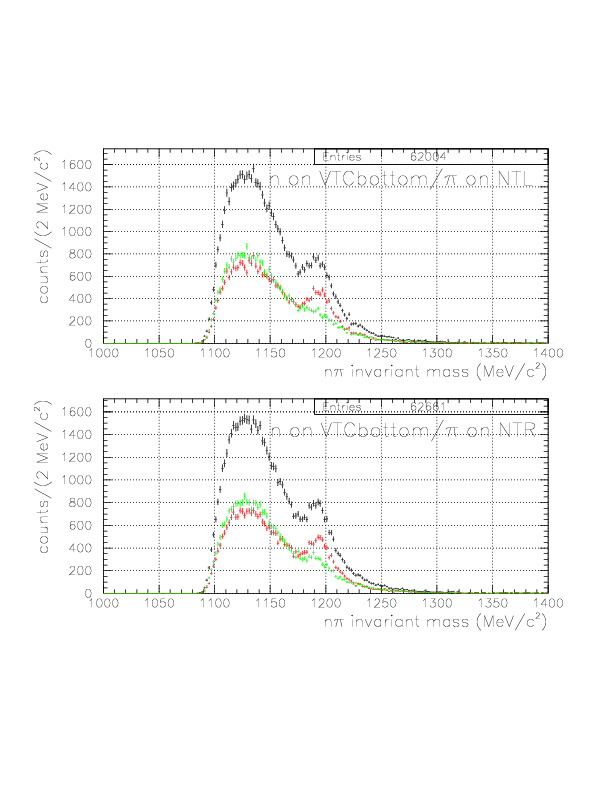
n&pi invariant mass spectra/&Sigma N event definition for specific event sets
The topology-by-topology n&pi invariant mass spectra are plotted below for all 8 cases. As easily seen, the &Sigma yield and S/N ratio are much different between the events, hence we do need to invoke special selections case-by-case.
Case-by-case n&pi invariant mass spectra. The events with positive VcaVn are plotted by red, while green if not.
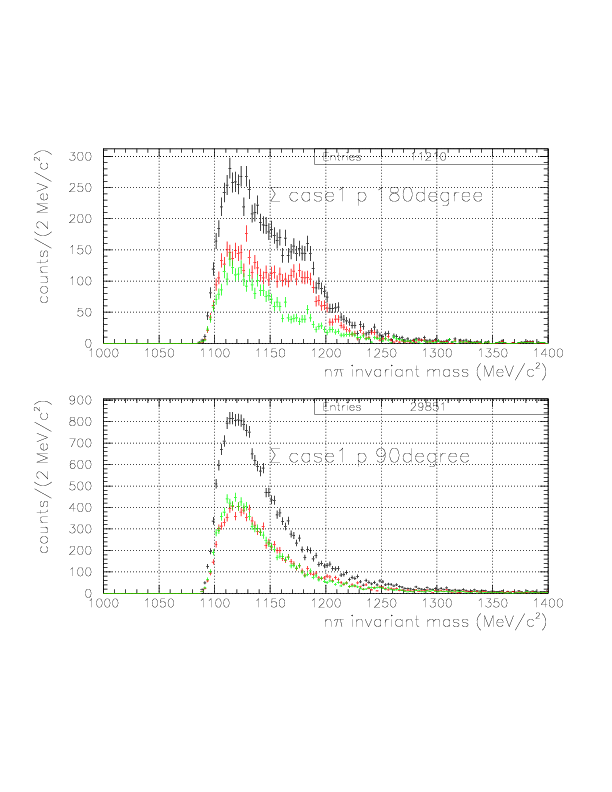

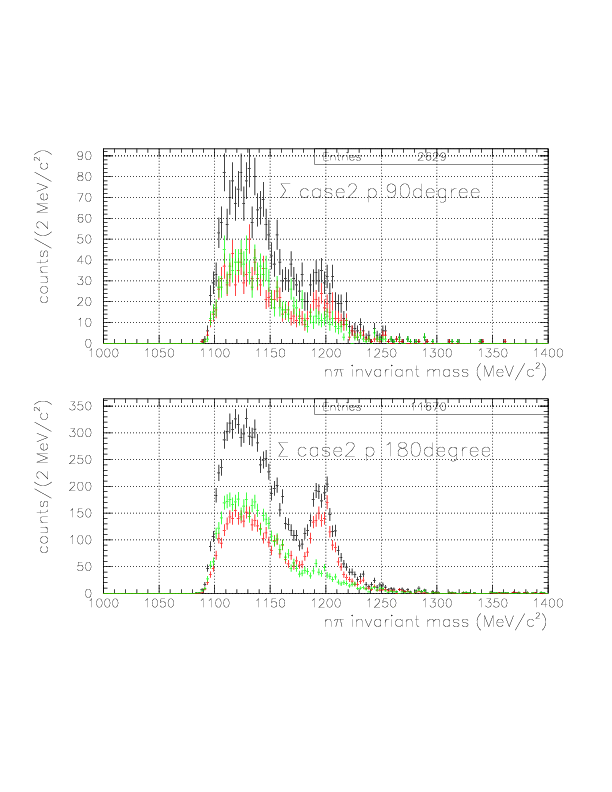

In order to identify &Sigma particle in a good S/N ratio, we commonly impose
1. neutron (both for primary and decay neutron) detection threshold 3 MeVee, and 1/&beta gate (1.6, 9.0).
2. VcaVn > 0. (only for topology 1~4 and 5~8)
3. decay-&pi momentum p&pi gate (135., 300.).
Furthermore, we impose further requirements for several special topologies as tabulatted below.
| YN pair(dibaryon/tribaryon channel) | Special requirements for decay pion | Special requirements for decay neutron | Special requirements for primary nucleon |
|---|
| &Sigma-p (case1 180degree) | p&pi>150 MeV/c | - | - |
| &Sigma-p (case1 90degree) | p&pi>150 MeV/c | 5 MeVeeth + 1/&betan < 7.0 + pn>200 MeV/c | - |
| &Sigma+-n (case1 180degree) | p&pi>150 MeV/c | 5 MeVeeth + 1/&betan < 7.0 + pn>200 MeV/c | 5 MeVeeth + 1/&betan < 7.0 |
| &Sigma+-n (case1 90degree) | p&pi>150 MeV/c | 5 MeVeeth + 1/&betan < 7.0 + pn>200 MeV/c | - |
| &Sigma-p (case2 90degree) | - | - | - |
| &Sigma-p (case2 180degree) | - | - | - |
| &Sigma+-n (case2 90degree) | p&pi>150 MeV/c | pn>200MeV/c | - |
| &Sigma+-n (case2 180degree) | p&pi>150 MeV/c | pn>200MeV/c | - |
| &Sigma-p (case3 90degree) | - | 5 MeVeeth + 1/&betan < 7.0 | - |
| &Sigma+-n (case3 90degree) | - | 5 MeVeeth + 1/&betan < 7.0 | - |
| &Sigma-p (case4 180degree) | | | - |
| &Sigma+-n (case4 180degree) | | | |
Final form of topology-by-topology n&pi invariant mass spectra.
Case1 p 180degree (top panel) and Case1 p 90degree (bottom panel). On both, the black is constructed under 300MeV/c>p&pi>135 MeV/c. The red is the subsets of the black fulfills the requirents for decay particles. The green is the one constructed from the complement.

Case1 n 180degree (top panel) and Case1 n 90degree (bottom panel). On both, the black is constructed under 300MeV/c>p&pi>135 MeV/c. The red is the subsets of the black fulfills the requirents for decay particles. The green is the one constructed from the complement.
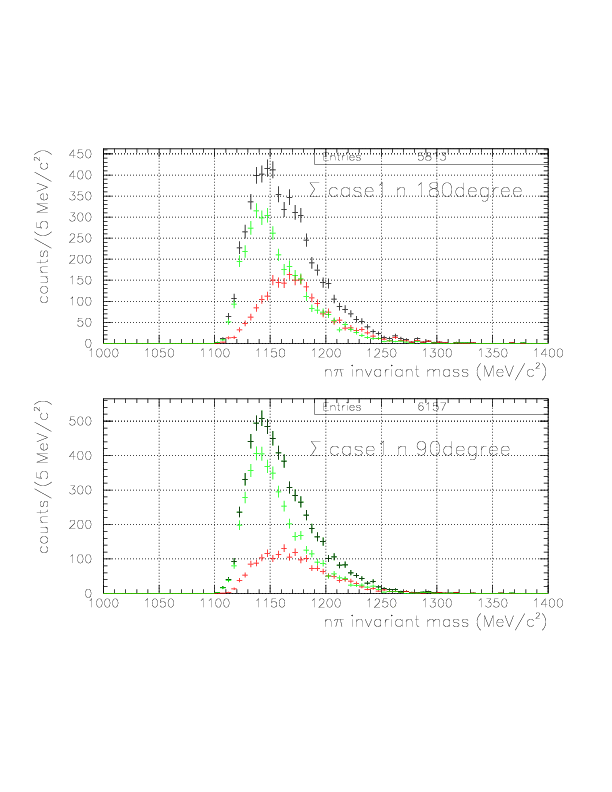
Case2 p 90degree (top panel) and Case2 p 180degree (bottom panel).
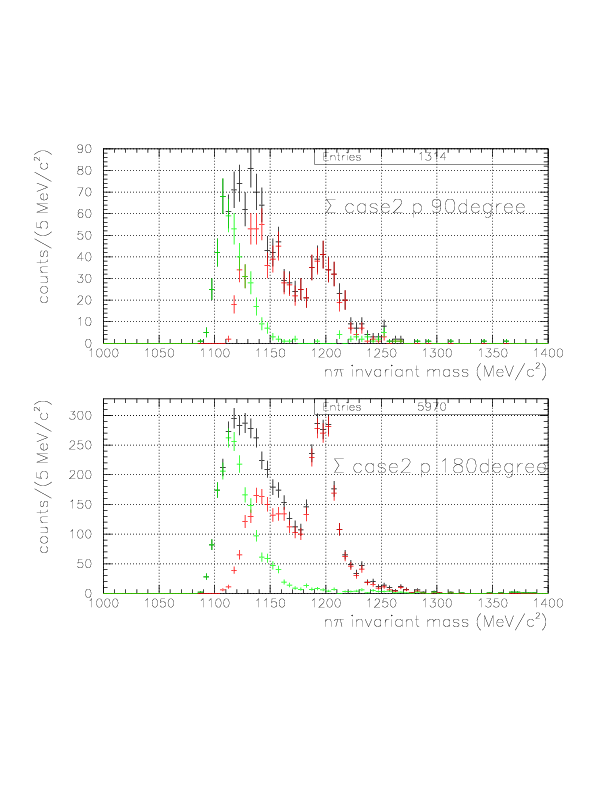
Case2 n 90degree (top panel) and Case2 n 180degree (bottom panel).
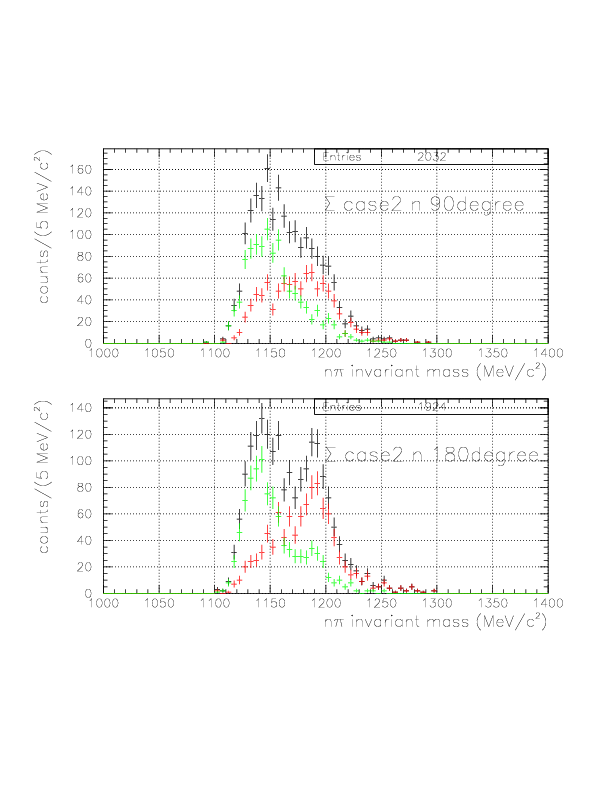
Case3 p 90degree (top panel) and Case3 n 90degree (bottom panel).

Case4 p 180degree (top panel) and Case4 n 180degree (bottom panel). No &Sigma component is found.
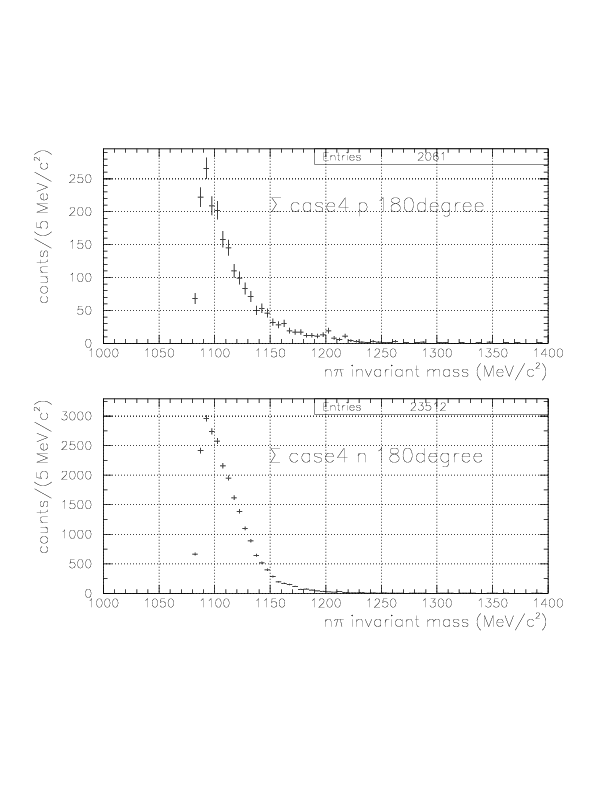
&Sigma N correlation analysis
&Sigma N event statistics for E549 cycle. For the primary neutron, selection A means the neutron detection software threshold (3~5 MeVee) and 1/&beta selection (1.6-7.0~9.0) to define physical neutron. For the primary proton, it is defined by successfull energy loss correction with 'reaction vertex' and layer B hit if the proton is measured on TC. Selection B is defined by the elimination of unhealthy PB counter hit(L-3, R-15).
| YN pair(dibaryon/tribaryon channel) | case ID(Selection) | Angler acceptance | PA/PB/NT particle | TC particle | No. of reconstructed &Sigma | No. of event after A | No. of event after B (yield of &Sigma N pair with well-defined momenta) |
|---|
| &Sigma-p(X0/S0) | 1(C-b-1-x/A-b-3-x) | 180+-30 | n+p | &pi | 1617 | 1569 | 1487 |
| &Sigma-p(X0/S0) | 1(C-b-x-1') | 90+-45 | n | &pi+p | 2179 | 1544 | 1544 |
| &Sigma+-n(X+/S+) | 1(C-b-3-x) | 180+-30 | n+n | &pi | 1562 | 992 | 992 |
| &Sigma+-n(X+/S+) | 1(C-b-x-3') | 90+-45 | n | &pi+n | 1189 | 1189 | 1189 |
| &Sigma-p(X0/S0) | 2(B-c-1-x) | 90+-45 | &pi+p | n | 272 | 258 | 232 |
| &Sigma-p(X0/S0) | 2(B-c-x-1'/B-a-x-3') | 180+-45 | &pi | n+p | 1676 | 1467 | 1387 |
| &Sigma+-n(X+/S+) | 2(B-c-3-x) | 90+-45 | &pi+n | n | 426 | 426 | 406 |
| &Sigma+-n(X+/S+) | 2(B-c-x-3') | 180+-45 | &pi | n+n | 515 | 515 | 487 |
| &Sigma-p(X0/S0) | 3(B-a-3-x) | 90+-45 | &pi+n | p | 991 | 695 | 657 |
| &Sigma+-n(X+/S+) | 3(B-c-3-x) | 90+-45 | &pi+n | n | 1379 | 1379 | 1305 |
The results are exhibitted below for all event topologies:
&Sigma case 1 p 180degree
&Sigma case 1 p 90degree
&Sigma case 1 n 180degree
&Sigma case 1 n 90degree
&Sigma case 2 p 90degree
&Sigma case 2 p 180degree
&Sigma case 2 n 90degree
&Sigma case 2 n 180degree
&Sigma case 3 p 90degree
&Sigma case 3 n 90degree

















